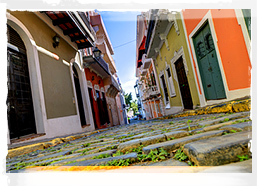An Introduction to Puerto Rico
Officially the Commonwealth of Puerto Rico, the territory consists of a main island and a number of much smaller ones. It was ruled by Spain for around 400 years, then ceded to the United States in 1898. Puerto Ricans became US citizens in 1917 and have elected their own Governor since 1947. A referendum on independence will be held in November 2012, but in three previous plebiscites the pro-independence party has polled well under ten percent. The precise nature of its relationship with the US is complicated and much discussed - see http://en.wikipedia.org/wiki/Puerto_Rico#Political_status. See full country profile.Latest Research News from Latin America

GOVERNMENT: Republic - 'Commonwealth' status, Self-governing territory belonging to the USA
AREA: 9,104 sq km
POPULATION: 3,706,690 (2011 est.)
MAJOR LANGUAGE: Official Languages: Spanish (most common) and English.

Some business and general info
The Market Research Industry
Trade and Industry in Puerto Rico
The main island's rainforests are home to a number of endemic and endangered species, most famous among which is the Coquí, a small frog easily identified by the sound of its call, and a symbol of Puerto Rican pride. 13 of its 17 species live in the northeastern El Yunque rainforest. [NB frog != toad we know, just a very poor pun, yes thank you]
Go to next country
Officially the Commonwealth of Puerto Rico, the territory consists of a main island and a number of much smaller ones. It was ruled by Spain for around 400 years, then ceded to the United States in 1898. Puerto Ricans became US citizens in 1917 and have elected their own Governor since 1947. A referendum on independence will be held in November 2012, but in three previous plebiscites the pro-independence party has polled well under ten percent. The precise nature of its relationship with the US is complicated and much discussed - see http://en.wikipedia.org/wiki/Puerto_Rico#Political_status.
With a tropical climate, the territory is mostly mountainous with large coastal areas in the north and south. Rapidly industrialised in the 1950s, Puerto Rico is now the second most densely populated of US states and territories. The island is now a major tourist destination as well as a global center for pharmaceutical manufacturing.
GDP: $108.4bn 'PP (2010 est.); $27,384 per capita
Religions Roman Catholic 85%, Protestant and other 15%
Currency: US dollar
Telephone Code: +1 787 and +1 939
Over the course of the last century Puerto Rico moved from an economy based on sugar plantations to one in which the main agricultural output is dairy and other livestock products and industry has overtaken farming as the main source of export income. The country's slightly unorthodox status with the US has pros and cons: in its favour, the US contributed to the move away from an agrarian economy by building factories and helping with tax breaks; however some US companies (like Apple and Best Buy) still treat Puerto Rico like a foreign state when it comes to sales tax and the country is subject to US minimum wage legislation which is making it harder for it to compete internationally. Most authorities acknowledge that the uncertain status question is limiting the economy.
Tourism represents approx 7% of the country's GDP, mostly in the shape of US cruise ships, and in the opposite direction so many Puerto Ricans have moved to the US. In 2003 the US Census Bureau estimated that more people of Puerto Rican birth or ancestry live in the US than in Puerto Rico (mostly New York City).
Exports from the island consist of chemicals, electronics, apparel, canned tuna, rum, beverage concentrates and medical equipment, this is overwhelmingly to the US (90.3%). Imports are chemicals, machinery and equipment, clothing, food, fish and petroleum products. TheUS (55%) and Ireland (23.7%) are the main sources.
Email me:
laurence@mrweb.com

